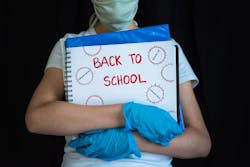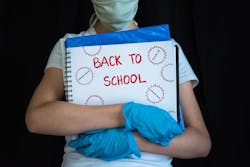The Need to Redefine Campus Security in Turbulent Times
The last eighteen months have provided a nearly unprecedented test for school security professionals in the United States, their colleagues, and their organizations’ crisis response plans. The outbreak of a global pandemic in March 2020 forced schools from inner-city public schools to Ivy League universities to quickly adjust their operations to continue educating their students while at the same time seeking to protect the students and the rest of the campus community from the rapidly spreading virus.
As state and local governments issued executive orders to combat the virus’ spread, schools were forced to shut down for a short period or speed through the development of interim safety measures over quickly repurposed spring breaks with the intention of delivering remote instruction for a few weeks or at most the remainder of the 2019-2020 school year to “flatten the curve” These steps were taken to allow the country to return to normal. Very few, if any, expected it to have a major impact on their operations throughout the entirety of the 2020-2021 school year.
If completely adjusting their operations in response to a pandemic was not enough, the United States was rocked by societal unrest from multiple sources that sparked demonstrations resulting in civil disobedience, along with political polarization that also threatened violence, security officials faced mounting challenges.
Adjusting to the New Normal
It was within this rapidly shifting landscape that the school security professional had to adjust their programs over the course of the 2019-2020 and 2020-2021 school years.
In response to the initially unchecked spread of the coronavirus, schools were forced to shut down in-person classes and determine how to offer services virtually via video conferencing solutions that were unfamiliar for both the staff and students. While teachers and students struggled to adjust to this new normal and learn the unfamiliar video conferencing classroom, school security professionals had to adjust their physical security programs to focus on securing empty buildings rather than buildings that normally teamed with activity both during the school day itself and with afterschool and athletic activities during many of the times that classes were not in session. The need to make this shift was enhanced as many areas experienced a significant increase in commercial burglary of newly emptied buildings, which was especially prevalent in areas where commercial properties were located near residential areas[1], as is typically the case for schools.
In addition to concerns related to the protection of the now-empty school buildings, schools were forced to rethink how their educators, mental health professionals, and security administrators identified and addressed concerns related to the safety of students. The sudden isolation in their homes, stress related to the new environment, changes in their family dynamics due to suddenly unemployed caretakers, and the uncertainty caused by the pandemic and the civil unrest were all detrimental to students’ mental health[2]. Many school districts also faced the daunting challenge of accurately tracking students in the new reality of virtual education. Districts across the nation still have many students, in some cases thousands of students, who did not participate in online learning and have had no contact with the school district since the transition from in-person classes.[3]
Most K-12 school districts and institutions of higher education have well-developed processes in place that allow them to identify students who are suffering from mental health concerns and may present a risk of violence to themselves or others, or alternatively who may be experiencing abuse or neglect at home. With the advent of online schooling these processes, which relied heavily on observations made during the staff’s daily interaction with students, were no longer optimal and schools were forced to quickly develop practices to assess these safety concerns and support students’ safety in a virtual environment[4] and to identify potential threats as they brought students back into the classroom.
As the 2020-2021 school year began schools were forced to determine how they were going to address the ongoing pandemic. Considering differing local regulations and public sentiments there was no one-size-fits-all answer and schools adopted a variety of options varying from remaining totally remote and providing all instruction via remote learning, attempting to re-start classes fully in person with adjustments to their operations involving extended hygiene protocols and social distancing, to a multitude of variations of hybrid remote and in-person options.
The Stress on Security
The impact of pandemic preparedness was felt throughout the school security world. Security personnel found themselves tasked with a variety of new pandemic-related duties such as COVID-19 screening prior to building access, enforcing social-distancing and mask policies, and utilizing medical safety precautions when dealing with people in person. School security departments and law enforcement agencies faced staffing shortages due to quarantine and isolation of officers as they were exposed to the virus. Stress and mental health issues were prominent among security and law enforcement personnel as they struggled to perform their duties while much of the country worked remotely.
When returning to in-person activities schools needed to ensure their communities that they were doing everything possible to prevent the potential spread of infection. This included implementing distancing measures in the classrooms and adjusting how people moved into and through their campuses and utilized spaces for students that were not designed as classrooms. In many cases, these adjustments were prioritized and had to be undertaken without consideration of their effect on the campus’ security measures. In some cases, schools that had been designed with security in mind ended up bypassing security measures by propping open multiple exterior doors throughout the day to prevent crowding at the entrance or placing students into spaces such as tents and outdoor classrooms lacking security measures built into their classrooms.
As schools begin to return to normal operations for the 2021-2022 school year, security professionals will need to remind their institution’s administrators of the need to reassess whether previous operational changes have inadvertently negated some of the security measures that have been put in place in the past. An effective security strategy assumes that all security measures are inherently porous, none can be completely invulnerable to all potential threats, and all will have some gaps that are exploitable. Security measures are most effective when deployed to form overlapping layers of protection that work as a coordinated system and minimize the risk of any singular threat successfully breaching all of the individual layers of the institution’s security measures. However, when one or more layers have been removed, the risk can become significantly higher, presenting a possible threat to the organization, its staff, or students.
Technology, Procedure and Socio-Economic Influences
In other cases, school security officials eager to demonstrate the value of their programs were quick to adopt security technology that promised to help reduce the risk of spread of the virus, including replacing physical keys with touchless electronic access control options, leveraging emergency notification systems to help keep their communities abreast of rapidly changing requirements and plans, upgrading their video surveillance systems with the addition of thermal cameras at building entrances which many companies claimed would be effective in detecting infection through sensing of elevated body temperatures. Others added video analytics packages to existing surveillance systems or installed new systems capable of utilizing analytics that could aid in compliance by detecting those wearing facemasks or by counting persons in an area to provide a tool for preventing overcrowding.
Many of these technology improvements were funded through grants specific to pandemic relief from state and federal government, but in cases where outside funding was not available, they were absorbed into the operational costs of the school’s security function often displacing other necessary improvements as many institutions felt financial pressures by a rapidly decreasing tax base.
Those institutions that were able to leverage grant funding to make improvements to their overall security posture by optimizing existing or installing new security systems will be well situated for the return to normalcy well beyond their pandemic-inspired purpose. Those who were forced to expend already scarce budgetary resources to purchase technology of dubious value may struggle to recover in a post-pandemic security landscape.
Budgetary concerns, the need to maintain social distancing, and the lack of staff presence on many campuses led to the suspension of normal activities including training for security personnel and the rest of the campus’ staff on emergency response procedures and other security protocols. Many institutions that had standardized and provided training for staff on crisis de-escalation, physical security protocols, active threat response, and threat assessment and management find themselves forced to re-educate staff on these perishable skills and provide initial education for all new staff who began their employment after March of 2020. These new employees may not have received the same extensive onboarding as they would have received pre-pandemic. School security professionals’ efforts to make these adjustments as schools began re-opening were exacerbated by the need to adjust their security programs to shifting community expectations for campus security and university police departments.
While schools were rarely the target of property damage aimed at police and other government facilities and the ancillary looting of commercial business during the civil unrest driven by these social movements and the anger over the contested presidential election, educational institutions still need to take these issues into account when developing their ongoing protection strategies. Civil unrest can place an institution’s staff and students in danger when occurring in areas along their commute to and from campus. Demonstrations on campus can affect operations and can have a profound effect on the mental health of their students.
The social justice narratives brought on by various movements have further led communities and the educational institutions that serve them to question many of their long-held assumptions about how their campus community should be secured. Universities that have for decades had their own full-service police departments staffed with armed law enforcement officers with full arrest powers are now receiving pushback from members of their communities. Some wonder if a campus police department is the most effective way to provide for the safety and security of all members of the campus community.
Many K-12 public school districts and charter schools are facing similar questions regarding their relationship with local law enforcement and the use of School Resources Officers embedded on their campuses. The social justice movement’s effect on campus safety has not been limited to police presence on campuses, the argument has also been made that traditional Crime Prevention through Environmental Design (CPTED) measures used extensively by educational institutions to reduce crime and influence behavioral on their campuses does not take into consideration how this affects historically disenfranchised communities[5] and that the extensive use of video surveillance technology is disproportionately used to monitor persons of color[6].
As a result, some school districts have ceased providing funding to staff school resource officers in their schools[7] and some universities have discussed disbanding or disarming[8] their in-house police departments. Regardless of whether this becomes the “new normal” or is just an overreaction and swing of the pendulum that will be rapidly reversed, going forward it will be even more important for the school security professional to take into consideration the needs and desires of their individual campus communities when determining what measures to take to best protect them.
This ability to shift focus from traditional methods of securing the campus environment and think “outside of the box” to evaluate and implement methods that better meet the changing needs of the campus community will be the defining characteristic of the successful campus security professional as the nation moves forward out of the pandemic and its most recent contentious election cycle.
School security personnel must be nimble and adapt quickly to ever-changing security threats that emerge and must be flexible to adapt policies, utilize new and existing technologies, and adjust personnel duties to meet new security challenges.
About the authors: Kevin Davis, J.D., CPP has over 24 years of experience in the security industry, most of which has been in the educational setting. Kevin earned a B.A. from Harding University and a Juris Doctorate from the UALR William H. Bowen School of Law. He is the Assistant Director of Public Safety and the Title IX Coordinator at Harding University, where he is responsible for the safety and security for the university as well as Harding Academy, a pre-K through 12 schools. He is Chairman of the ASIS International School Safety and Security Community. Kevin has had several articles published in magazines and journals and has spoken at numerous conferences and seminars about school safety.
Drew Neckar MBA, CPP has nearly thirty years of experience in the safety and security field. He has served in senior security roles for organizations in several sectors including service as a regional Security Director for Mayo. He has presented on various security-related topics at regional and national conferences and has been published in multiple professional journals. Drew holds a Certified CPTED Professional (CPD) designation from the National Institute of Crime Prevention, is board certified as a Certified Healthcare Protection Administrator (CHPA) by the International Association or Healthcare Safety and Security, a Certified Protection Professional (CPP) by ASIS International and serves as the Vice-Chair of that Organization’s School Safety Steering Committee. He owns and operates Security Advisors Consulting Group a full-service security consulting and litigation support firm.
Footnotes:
[1] Felson, M., Jiang, S. & Xu, Y. Routine activity effects of the Covid-19 pandemic on burglary in Detroit, March, 2020. Crime Sci 9, 10 (2020). https://doi.org/10.1186/s40163-020-00120-x
[2] Joyce Lee, Mental health effects of school closures during COVID-19, The Lancet Child & Adolescent Health, Volume 4, Issue 6, 2020, Page 421
[3] Mirtopoulos, Arielle. With Return to In-Person Learning, Thousands of Students Still “Missing” From Schools. ABC News (June 2021). https://abcnews.go.com/Health/return-person-learning-thousands-students-missing-schools/story?id=78051068
[4] NASP School Safety and Crisis Response Committee. (2020). Behavior Threat Assessment and Management in the Virtual Environment. [handout]. Bethesda, MD: National Association of School Psychologists.
[5] Krause, Karl. “WHOSE EYES ON THE STREET?” Landscape Architecture Magazine. May 11, 2021. https://landscapearchitecturemagazine.org/2021/05/11/whose-eyes-on-the-street/
[6] Crockford, Cade. “How is Face Recognition Surveillance Technology Racist?” ACLU.org, June 16, 2020. https://www.aclu.org/news/privacy-technology/how-is-face-recognition-surveillance-technology-racist/
[7] Fox, Madeline. “Milwaukee Public Schools Terminates Contract With Milwaukee Police Department
Board Of School Directors Voted Unanimously To End Funding For School Resource Officers” Wisconsin Public Radio. June 18, 2020. https://www.wpr.org/milwaukee-public-schools-terminates-contract-milwaukee-police-department
[8] Hidalgo Bellows, Kate. “Portland State U. Is Disarming Its Campus Police.” The Chronicle of Higher Education. June 17, 2021. https://www.chronicle.com/article/portland-state-u-is-disarming-its-campus-police-activists-say-its-a-media-stunt
About the Author

Drew Neckar CPP, CHPA
Principal Consultant leading the healthcare vertical, among other areas, for the global physical and information security practice at COSECURE.
Drew Neckar CPP, CHPA has nearly thirty years’ experience in the safety and security field. He has served as the senior most security executive (CSO) for healthcare, financial services, education, and hospitality organizations and as a Regional Security Director for Mayo Clinic. He has presented on various security-related topics at regional and national conferences and has been published in multiple professional journals. Drew is board certified as a Certified Healthcare Protection Administrator (CHPA) by the International Association or Healthcare Safety and Security, a Certified CPTED Specialist by the American Crime Prevention Institute, a Certified Protection Professional (CPP) by ASIS International and serves on that organization’s Healthcare Security and School Security Councils. Drew owned and operated Security Advisors Consulting Group a full-service security consulting firm and serves as the Vice President of Operations for Security Management Services International Inc. However, when SACG joined forces with COSECURE Enterprise Risk Solutions, Drew assumed the role of Principal Consultant leading the healthcare vertical, among other areas, for the global physical and information security practice at COSECURE.

Kevin Davis, J.D., CPP
Assistant Director of Public Safety and the Title IX Coordinator at Harding University.
Kevin Davis, J.D., CPP has over 24 years’ experience in the security industry, most of which has been in the educational setting. Kevin earned a B.A. from Harding University and a Juris Doctorate from the UALR William H. Bowen School of Law. He is the Assistant Director of Public Safety and the Title IX Coordinator at Harding University, where he is responsible for the safety and security for the university as well as Harding Academy, a pre-K through 12 school. He is Chairman of the ASIS International School Safety and Security Community. Kevin has had several articles published in magazines and journals and has spoken at numerous conferences and seminars about school safety.

